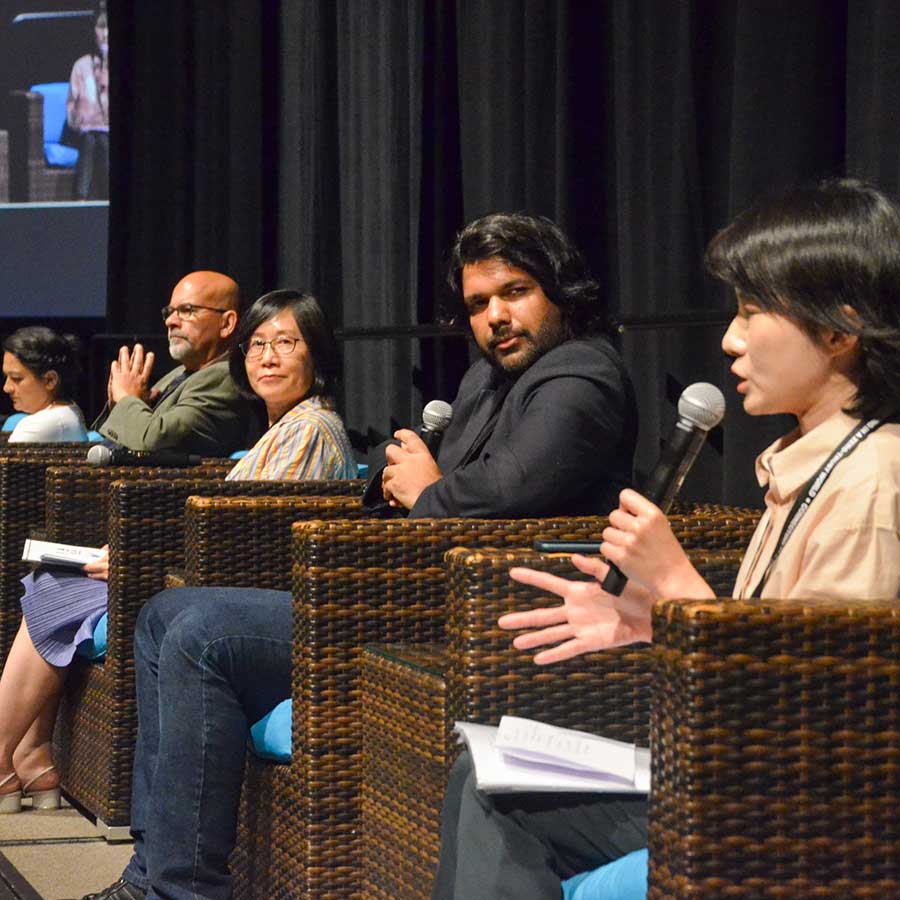
HONOLULU, Hawaii – Lack of trust in the news media isn’t exactly news itself these days.
But amid fresh evidence of the problem, “There is something deeply different about the current crisis,” according Hong Kong media studies professor Cherian George, one of more than 40 speakers at the 2022 East-West Center 2022 International Media Conference here last week.
“It feels more intractable, and beyond the control of the profession,” George said.
Participants from 35 countries gathered in person and virtually for the conference to evaluate the state of the media at an especially troubling time across the globe.
The ongoing pandemic, rampant misinformation, concerted attacks on journalists, a rise in authoritarianism and the dominance of social media are feeding the view that restoring news media trust may be even more of a daunting task now than previously.
When good journalism breeds low trust scores
George, a professor of media studies and associate dean for research at the Hong Kong Baptist University School of Communication and Film, said journalists thought that producing high-quality journalism would increase public trust.
But in fact such respected media outlets as Nobel Peace Prize recipient and conference keynote speaker Maria Ressa’s Rappler.com and reliable news organizations in India actually receive low trust scores, suggesting that journalists who probe deeply and confront the powerful tend to draw attacks which then lower their public standing.
“We have to acknowledge that trustworthiness, while necessary, is not a sufficient condition for public trust,” said George, speaking on a panel of journalists and researchers examining the low trust in media at the conference on the theme “Connecting in a Zero-Trust World.”
Frayed connections or ‘neutral’ trust?
The 2022 Reuters Institute Digital News Report released last month describes a stressful environment for news outlets competing for the public’s attention against online creators, influencers, activists and politicians. One result is that the “connection between journalism and much of the public is fraying,” the report said.
Although last year saw a bump in media trust attributed to the coverage of COVID-19, the report noted that news consumption has since dropped in many countries and trust widely declined.
A recent “trust barometer” survey by Edelman, a communications firm that tracks public trust in major institutions, ranked the media as the lowest compared to governments, businesses and nongovernmental organizations, continuing a decline seen since 2020.
Still, the scores covering media from selected nations in Asia, the Pacific, and Europe, along with the US and Canada, assign the industry to a “neutral” category, meaning neither trusted nor distrusted. Edelman president and CEO for Asia Pacific Stephen Kehoe told conference attendees that, broadly speaking, trust in media has been flat over the past 10 years.
“One of the things we do note is that where trust in government has been falling, there typically is a flight to other institutions,” Kehoe said.
“And where government is closely tied to the media in one form or another, when a government becomes distrusted so does the media and when a government enjoys high trust, then the media does as well. In the countries where there is a much looser association between the two, they move independently.”
Few new answers
A lack of new answers to the question of why so many in the public continue to distrust journalists points to the difficulty in addressing the problem. Lack of newsroom diversity, long an industry failure, remains a factor negatively affecting media credibility.
Although several major news outlets in the US have appointed women and people of color to top jobs in recent years, more work is needed to regain generations of lost trust, said Alan Miller, founder and CEO of the News Literary Project, which works with educators nationwide to teach students news fact-checking skills.
Beyond race and gender, many people feel the news is not made for them. Among them are those who mistrust the media as a part of their political identity and connect with others who feel the same way, said Joy Mayer, founder and director of Trusting News.
Her group studies how people decide what news to trust and develops strategies for journalists to increase their credibility with the communities they cover.
Mayer said when people don’t trust the news media, they find their own information sources, and that may include irresponsible outlets.
“How can we instead build those bridges and help people better navigate and respond to misinformation?” Meyers asked.
Part of that work may involve sites like mediamanipulation.org, which documents how technology is used for misinformation and disinformation campaigns.
Targeted manipulation
Journalists are targeted by information manipulators because they know they can break into the public discussion through the media, said Joan Donovan, research director at Harvard University’s Shorenstein Center on Media, Politics and Public Policy.
Donovan leads a team that is building an archive of case studies describing the methods and patterns used by disreputable actors. She said it is often when journalists successfully counter a manipulator’s narrative that they get attacked.
“Unfortunately, we are not in a position where we have a lot of great mitigation strategies,” she acknowledged.
Journalists who are targeted online can ask a social media platform to take down their address, for example, but they may not get help quickly.
Donovan urged journalists to collaborate and confront the threat of a society seeking information and “not just the curation and cultivation of facts.”
Exposing the sources of misinformation and disinformation is one part of the battle, panelists said, but journalists also need to address the demand side by understanding why people consume misinformation and making the case overwhelmingly for credible journalism.
“If we don’t address the demand side, we will cease to have an appreciation for quality journalism,” said Miller.
And that appreciation, he said, is exactly what is needed to drive public demand for trustworthy news and “help journalism continue to play an absolutely vital role in sustaining the public life of our communities and our democracies.” (https://www.eastwestcenter.org/node/43146)




















